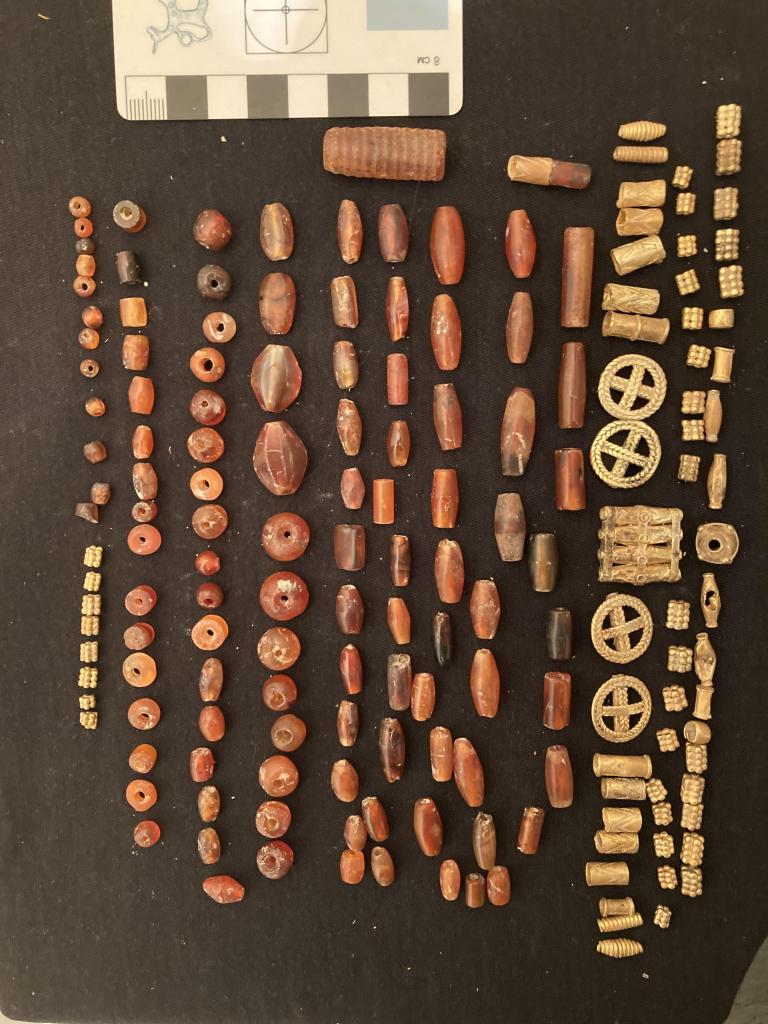Ty 🦀 
3 200-year-old gold necklaces, beads and jewellery in a double tomb from the Bronze Age
Categories: Nálezy nejenom s detektorem kovů ve východní Evropě
Armenian and Polish archaeologists have discovered a double grave from the Late Bronze Age with rich furnishings. Among other things, it contained gold and carnelian necklaces, bronze bracelets, gold and pewter pendants. The remains of two adults lay in a stone-lined box, which also contained the rare remains of a wooden burial bed and preserved Syro-Mesopotamian pottery.
The excavations were carried out in the necropolis of the archaeological site of 'Metsamor'. The newly presented double tomb No. 23 was investigated in the autumn of 2022. It dates from the period between 1300 and 1200 BC. It is in good condition, the tomb measuring 2.5 x 2.1 m has a cover of medium-sized stones. The burial chamber is paved with medium and large stones. It is oriented in the east-west direction. Two individuals lay on the wooden burial bed in a slightly bent position, touching at the pelvic bones, with the left and right sides respectively.
Ten well-preserved ceramic vessels were found in the same layer, some of which were placed under the stretcher. Below this layer were 8 more ceramic objects, the rarest of which is a small blue-green glazed vessel with two through-holes in the upper part. On the neck and chest of the skeletons were found cylindrical and round beads, pendants of gold, carnelian, amber and tin. The wrists of the first individual were decorated with bronze bracelets, and tin buckles were located in the abdomen. The wrist of the second skeleton was adorned with a bracelet of thin tin wire. The skeletal remains of a man and a woman have been tentatively identified.
The deceased were aged between 30 and 40 years at the time of death: "The deaths of these people are a mystery to us, we do not know the cause, but all indications are that they died at the same time, as we have no trace of the tomb being reopened," explained the head of research, Prof. Krzysztof Jakubiak from the Faculty of Archaeology of the University of Warsaw in a press release. The discovery is rare not only because it is a paired grave, but especially because it is one of the few local graves that has never been looted.
The Bronze Age citadel of Metsamor was built on a hill overlooking the Ararat plain. Experts do not know by whom, as the local inhabitants were illiterate and left no written evidence. For the past ten years, a mixed team of Polish and Armenian archaeologists have been working here, exploring the citadel and the lower town. They have found evidence of settlement from the Bronze Age to the Middle Ages.
In the 4th to 2nd millennium BC, the settlement covered more than 10 hectares and was surrounded by Cyclopean walls. It continued to grow in the Early Iron Age (11th-9th centuries BC), reaching almost 100 hectares. With its at least seven temples, Metsamor was one of the most important political and cultural centres of the valley. From the eighth century onwards, it belonged to the Urartian (Bliblichian Ararat) empire, which included parts of present-day Turkey, Iraq, Iran and Armenia. The site was continuously inhabited until the 17th century.
The prehistoric necropolis lay about 500 m from the walls. It was first explored in the 1960s; so far it has revealed more than 100 graves from the Middle Bronze Age to the Iron Age. Chamber graves and stone-stacked graves predominate, and there are also kurgans (cairns) and cromlechs (circular stones arranged on top of a burial chamber).
Roman Němec
naukawpolsce.pl, thehistoryblog.com, artnews.com, hushardzan.am





The article is included in categories:








